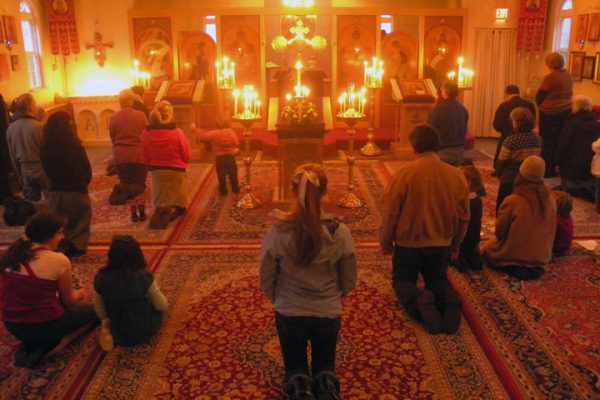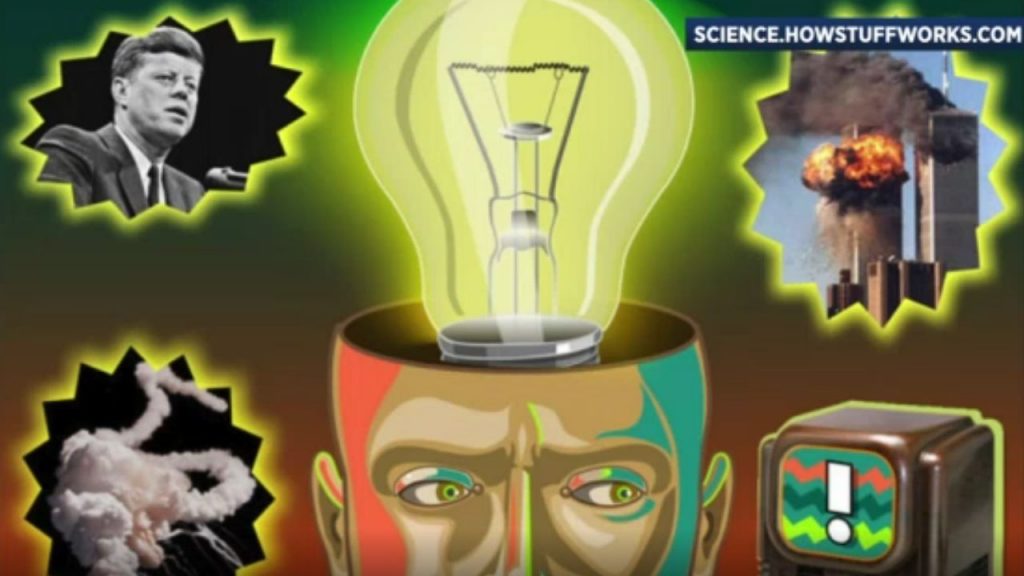
Like music, religion takes many forms – from the quiet and contemplative to frenzied and altered states of consciousness. Some religions are large organizations with longstanding doctrines and regular, relatively sedate rituals; others consist of smaller groups with very intense but less frequent ritual observances and wide variation in interpreting their meanings. In the 1990s anthropologist Harvey Whitehouse, drawing on his fieldwork in New Guinea in the 1980s, expounded an influential cognitive theory that sought to explain this widely divergent character of religious expression. Whitehouse proposed that “religiosity” always takes on one of two distinct modes: the doctrinal and the imagistic.
The doctrinal mode is identified by the following:
-
- — a set of established, orthodox doctrines
- — frequent ritual observances in a relatively calm atmosphere
The imagistic mode . . .
-
- — infrequent but highly intense emotional and physical ritual experiences
- — beliefs derive from personal reflection rather than standard public teachings
Key point: these two modes of religiosity do not define religions. Rather, both forms of religiosity can be found within the same religion. Islam, Christianity, Judaism — both modes of religiosity are found in each of these, for example.
Doctrinal and imagistic modes of religiosity are not types of religion but organizing principles for religious experience and action. It is very common for both modes of religiosity to be present within a single religious tradition. (Whitehouse 2002, 309)
Whitehouse’s theory is not simply descriptive: it seeks to explain why these modes emerge again and again throughout history, why some religions last many generations, why some mushroom but then soon afterwards whither away, how rituals seem to create different types of social organization.
Modes of Religiosity as Attractors
 Whitehouse borrows the notion of an attractor from the physical sciences. Certain physical systems function in a way to come to a standard pattern of behaviour. A pendulum will always swing towards its “straight-down” point until that’s where it rests. Weather patterns regularly form as various elements (humidity, temperature, etc) function in predictable ways to coalesce the same way each time, e.g. cyclones. Whitehouse’s theory is that certain psychological and environmental factors function in ways that lead to the same attractor positions each time, whether the imagistic or the doctrinal mode of religiosity.
Whitehouse borrows the notion of an attractor from the physical sciences. Certain physical systems function in a way to come to a standard pattern of behaviour. A pendulum will always swing towards its “straight-down” point until that’s where it rests. Weather patterns regularly form as various elements (humidity, temperature, etc) function in predictable ways to coalesce the same way each time, e.g. cyclones. Whitehouse’s theory is that certain psychological and environmental factors function in ways that lead to the same attractor positions each time, whether the imagistic or the doctrinal mode of religiosity.
Origin of the theory
We mentioned that Whitehouse developed his modes of religiosity theory from his fieldwork in New Guinea. A group that he was studying was a mainstream cargo-cult. Long before, indigenous peoples had come to believe that the technology of white people was divinely created (or created by their spirit ancestors) and gifted to white people because, they assumed, they had pleased the gods who made those “miraculous” gadgets. To acquire the same gifts for themselves they attempted to imitate the “rituals” of this white race that evidently pleased the gods: creating “airstrips” in the jungle; making “antennae” and “headphones” from bush materials.
Every so often, Whitehouse learned, a group would break off from this mainstream and go its own way with rituals and its own tight social organization. One case was precipitated by a man who fell ill and into delirium and in that condition he began making all sorts of odd ramblings. Those around him believed it was his ancestor who was speaking through him or inspiring those words. He seemed to be saying that the mainstream religion was wrong. People needed to be doing different things to receive the “cargo” of “magical” goods that only white people had.
One of the sentences companions of the ill man thought they heard him say was, “I am a post.” This came to be interpreted as meaning the ill man, or rather his ancestor, was to be the pillar or central support of a community (as a central post was the main support of a hut) of followers who would embrace new rituals to try to do more to please the spirit world. New dances, new processions, were arranged and performed around posts. The people became increasingly convinced that the return or appearance of the ancestors was very imminent. Soon they would be visited and given all those wonderful gadgets. The performances became more intense as it was believed the arrival of those spirits was ever more imminent. They punished their bodies with excessive eating, drinking, lack of sleep. Mass weddings were conducted to reduce the temptation of fornicating with the ancestors about to arrive.
Delay in the “coming” resulted in more frantic and desperate behaviour of those attempting to bring it about. People were confined to a single hut and not allowed to leave even for bodily functions. Violent exorcisms were performed. Hunger set in since all the cattle had been slaughtered and crops harvested in their excessive and urgent feasting in anticipation.
Thus the two modes appeared. The two attractors. People gravitated towards either the mainstream cargo cult or to the breakaway group with its extreme and unusual forms of ritual.
Why Rituals?
The two modes of religiosity are marked by quite different types of rituals. The doctrinal mode is marked by rituals of high frequency and low emotional intensity; the imagistic, with low frequency and high emotional and physical intensity. What is their function? What do they achieve?
Joining in ritual behaviour (and this goes beyond its application to the study of religion) signals that you belong to a group, that you embody your group’s mores, social conventions, values, thoughts. They signal that you can be trusted for being a reliable collaborative partner within the group. Adhering to a group’s ritual behaviours rewards one with the acceptance and trust of others.
Rituals in the Doctrinal Mode

But if we do something too frequently we become less emotionally attached to it. We can begin to repeat actions, rituals, “mindlessly”. We get bored.
That is the danger of the doctrinal mode of religiosity: frequent repetitions leading to boredom. Whitehouse refers to “the tedium effect“.
After one has spent years learning all the doctrines, what is there left to do? In school one attends regular classes to learn specific information but then one graduates and finds a job. After learning the religious teachings in a church, mosque or synagogue, one does not then leave; there would seem to be no point in continuing to repeat the same lessons over and over. But this is what devotees do through regular ritual observance. Why, and how is the tedium effect overcome?
The doctrinal modes have learned a few tricks to overcome this danger as they maintain the forever-repetitiveness of the doctrines:
-
- One of them is to teach the fear of hell for losing interest and drifting away.
- Another is the carrot: a promise of heavenly bliss for sticking with it.
- Another, the employment of persuasive orators, charismatic speakers.
That last point further enables the spread of the religion. New audiences are sought out and new converts are made. The religion can also pass easily from generation to generation.
The rituals become part of one’s “semantic memory“. Just as we remember many things that we can no longer recall ever learning (e.g. Paris is the capital of France, milk comes from cows, etc), so the rituals are practised from the same type of memory. It is all routine, rarely life-changing and generally not conducive to intellectual revisionism. There is more to it than semantic memory, however. There is also a routinized “procedural memory“.

One enters the doctrinal mode through long periods of instruction so that one comes to internalize the doctrines. The rituals performed, being repetitive, become as routine as riding a bike, driving a car or swimming. One does not think about doing them; one just does them with very little conscious thought. Hence in the practice of one’s religion there is little opportunity for people to reflect spontaneously on the meaning or significance of what they have been taught or what they are doing. There is accordingly little opportunity to rethink and revise the official meaning of the rituals. The teachings and rituals become part of our procedural memory. That’s why we have experienced going through the motions as if on auto-pilot, with minds elsewhere, and have seen the same in others.
In the doctrinal mode of religiosity we therefore have centralized authorities who keep the faithful
-
- united in their common subscription to the correct doctrines;
- united in their frequent and habitual performance of rituals, a performance that discourages reflection on their meaning and significance.
All of that enables the creation of religious bodies made up of very large groups. The orators are in a position to spread the ideas. People who join practice the same rituals and so feel part of the same community even though they often do not know one another personally. People in such a group have the benefit of a certain level of trust of one another and will enjoy cooperation in times of need. And such groups can become very large and long-lasting. Of course, a downside of the persuasive orator solution is that those same persons are in a position to challenge the doctrines and break off members to form rival groups.
Rituals in the Imagistic Mode

Here we meet the impact of a very different memory from the semantic one. Episodic memories are firmly rooted to a time and place in our lives. Think of weddings, births of children, thrilling concerts. Episodic memories are a part of our identity, our autobiography, but not all of these will endure with the same vividness throughout our lives. What do endure are flashbulb memories. Many of us remember where we were, who we were with, when we first heard the news of 9/11, for example. Great disasters, also moments of great joy such as the birth of children, can be the stuff of episodic memories. What makes them so different from other types of memory is that they often shape and give meaning to our lives. They come to mind at critical points in our lives and undergo renewed reflection.
Some of the most extreme rituals in the imagistic mode literally terrifying, mentally and physically tormenting and even life-threatening initiatory rites. Whitehouse speaks of “rites of terror”.
Terror is an integral component of religious experience in many of the societies of Papua New Guinea. Following a hair-raising account of penis-bleeding among the Ilahita Arapesh, Tuzin observes that the whole ordeal ‘is carefully and successfully designed to inspire maximum horror in its victims’ (1980: 74). Barth describes how a Baktaman novice was so terrified by the ordeals of initiation that he defecated on the legs of his elders and had to be excluded from the group of boys being initiated (1975: 56). In his analysis of Orokaiva initiation Schwimmer (1973: 177) approvingly cites Chinnery & Beaver’s (1915) claim that a function of the rites is to instil ‘absolute and lasting terror in the candidates’. In his discussion of Bimin-Kuskusmin initiation, Poole likewise emphasizes the terror of novices, observing that ‘the piercing of the nasal septa and the burning of forearms … created the most trauma, producing overt signs of physical and/or psychological shock in six cases’ (1982: 144). Examples could, of course, be multiplied. In this region terrifying ordeals are not confined to initiations; they may also be evident in such diverse contexts as mortuary rites (as in Schieffelin’s [1976] description of the burning of Kaluli dancers), possession (as in Williams’s [1928: 67] account of the injuries caused by supernaturally induced convulsions), and millenarian activity (as in Elbert & Monberg’s [1965: 399-400] transcription of an account of the bloodbaths resulting from a ‘cargo cult’ on the island of Bellona). It would not be unduly fanciful to describe these sorts of practices as ‘rites of terror’. (Whitehouse 1996, 703)
These kinds of experiences stay with one forever as flashbulb memories and are regularly contemplated for meaning and significance. There is no hierarchy of orators to set out the exact teachings. We have, rather, a spontaneous, personal set of ongoing ruminations and deciphering of meaning. The process may take a lifetime. Each person will acquire his own meaning. Whitehouse uses the term spontaneous exegetical reflection (SER). SER does not encourage reflection on whether the rituals should be performed. The justification of the experience is not questioned. The experiences lead to searches for meaning of the rituals.
Religious understandings are therefore varied. And with no religious authority to police the viewpoints emerging there is no scope for a centralized religious movement. The communities remain relatively small. The bonds within those communities, however, are unlike the anonymous bonds in doctrinal modes of large religious communities. The bonds in the imagistic mode are intensely personal. Compare “bands of brothers” of soldiers who have been on operations. Cooperation goes beyond helping out in times of need; in the imagistic mode the cooperation will be so intense that lives will be devoted to each other. They really will lay down their lives for their fellows. (There are other parallels with the military bonding, too. Think of the many rituals involved: hairstyles, clothes, eating together, sleeping together, drills. Those rituals create a cohesive unit but they are not high emotional intensity rituals. Those usually come from the battlefield experience.)
What binds the community in the imagistic mode is shared experiences, not shared doctrine.
Origins?
It would seem plausible to think that the doctrinal mode evolved with the emergence of large-scale human settlements.
Before then, the imagistic mode may have functioned to create tightly bonded groups in environments where survival was precarious. The group depended upon members willing to sacrifice their lives to protect the group against mortal threats. It has survived today to produce “some of the most revered, as well as some of the most reviled, acts in history.”
Whitehouse, Harvey. 1996. “Rites of Terror: Emotion, Metaphor and Memory in Melanesian Initiation Cults.” The Journal of the Royal Anthropological Institute 2 (4): 703–15. https://doi.org/10.2307/3034304.
———. 2002. “Modes of Religiosity: Towards a Cognitive Explanation of the Sociopolitical Dynamics of Religion.” In Method & Theory in the Study of Religion, 293–315. Leiden: Brill. https://ora.ox.ac.uk/objects/uuid:936b902a-e15c-4464-af6c-55a03ac9f2f8
———. 2008. “Cognitive Evolution and Religion: Cognition and Religious Evolution.” Issues in Ethnology and Anthropology 3 (3): 35–47. https://doi.org/10.21301/eap.v3i3.2.
If you enjoyed this post, please consider donating to Vridar. Thanks!


There doesn’t seem to be a theory there, merely a classification, but I think there may be a simpler explanation for the two classifications of religions seen: in every culture, those who “have” (wealth, status, position (power), etc.) are Apollonian, that is in favor of “law and order.” Those who seem disaffected from the current status quo (e.g. early Christians, racial minorities who suffer suppression/slavery, etc.) are more likely to be Dionysian. For example, you don’t see a great many wealthy people attending charismatic churches.
So, this range of mode of expression may be due to political reasons and not religious. It is exacerbated by religions being part of both political positions: there are churches that reinforce law and order and those which challenge it (e.g. liberation theology).
What comes to mind is the New Testament’s complete absence of criticism of their Roman oppressors. Would Christianity have acquired state power had it been anti-Roman or even anti-slavery? I think not. Christianity is a “keep the status quo, law and order” organization and, as such is favored by those in power. And it is not beyond imagination to believe that it was deliberately shaped that way.
Both fall into the doctrinal mode insofar as they are both expressions of formalized and authorized teachings of hierarchies and adherents observe the low-intensity but frequent rituals that have the functions set out in the post.
PS Very much prefer the new design! Well dome! Much easier to read. Didn’t fall into the bells and whistles trap! Good work by the team!
The team is Tim.
Tedium can have value for the devotees.
Frequent, standardized prayer is essentially mantra-meditation. Even if the devotee is told to ‘think’ about the meaning of what they are saying, the prayer goes by too fast.
There’s also the devotee’s pride in having mastered the prayer and ritual, and having become a full participant. (And now able to help/look down on beginners/outsiders)